Assessing Hydrokinetic Energy in the Mexican Caribbean: A Case Study in the Cozumel Channel
Abstract
1. Introduction
2. Methodology
2.1. Case Study
2.1.1. The Present Energy Scenario in the Mexican Caribbean
2.1.2. The Study Area
2.2. The Turbines
- The NOVA M100-D turbine (100 kW), Figure 4a, was developed by NOVA INNOVATION Ltd., UK [47]. It has a direct drive technology, using a simple rugged low-speed generator to directly convert the rotation of the blade into electricity. The rotor is 8.5 m in diameter and its nominal power is 100 kW at 2 m/s. The rotor is bi-directional. The system is fixed by gravity onto the seabed, so it does not require anchors or drilling.
- The Sea Gen turbine (1.2 MW), Figure 4b [48], was developed by Marine Current Turbines Ltd., now called Atlantis, UK. A prototype using this turbine was installed in 2008, but it is currently out of service. It had two 600 kW turbines working at ~2.5 m/s current speed, with two 16-meter diameter rotors. It lies on the seabed, needing foundations that require drilling.
- The TidGen (150 kW), Figure 4d [50], was developed by Ocean Renewable Power Company ORPC, USA, and has four helical-type cross flow turbines, coupled to a single generator. Because of its elongated shape, it works well at shallow sites. At present, it is being considered for a tidal power project in Cobscook Bay, Maine, USA. It lies on the seabed and does not require anchors or drilling.
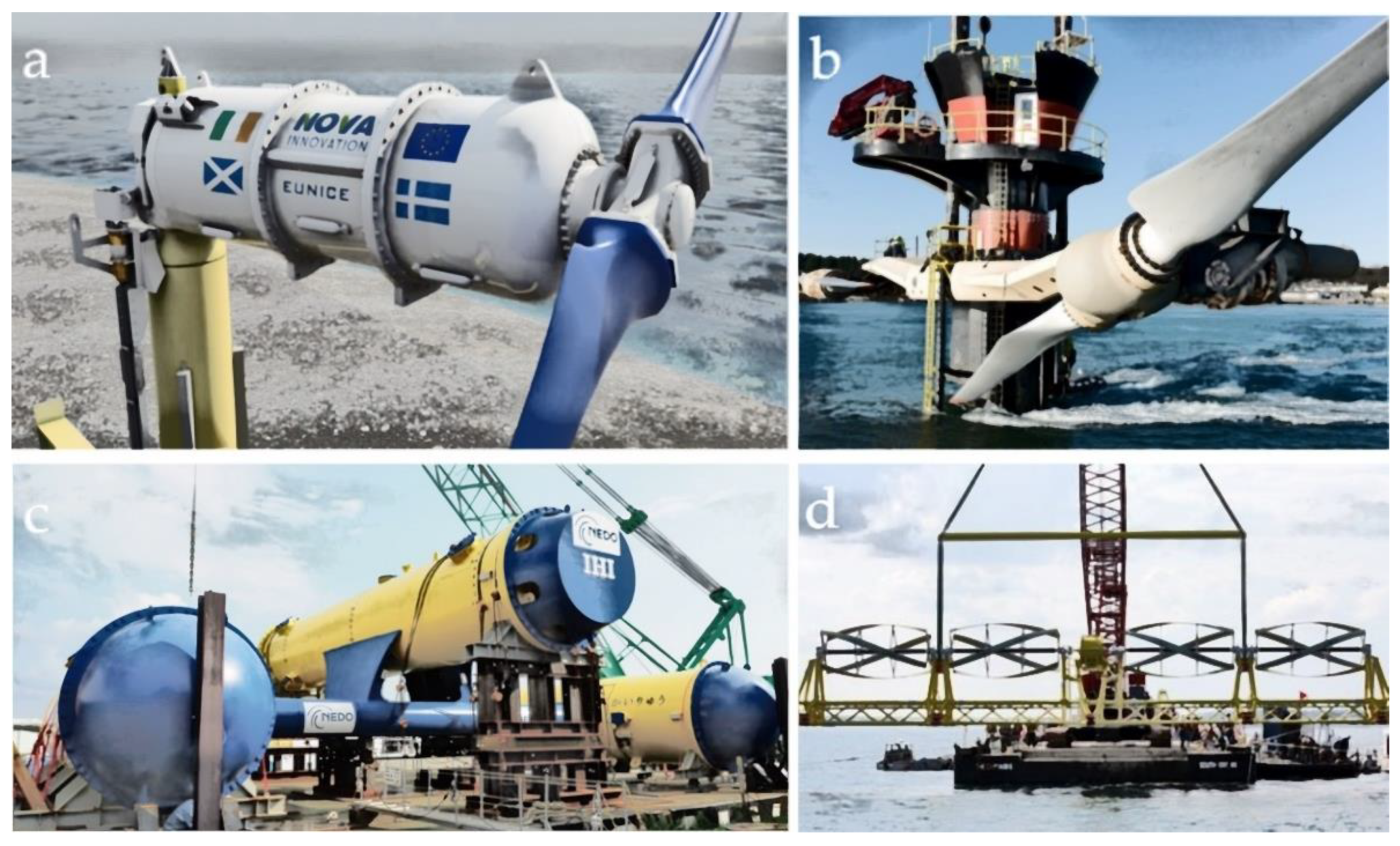
| Sea Gen i | NOVA ii | Kairyu iii | TidGen iv | |
|---|---|---|---|---|
| Nominal power (kW) | 1200 | 100 | 100 | 150 |
| Type | HATT * | HATT * | Horizontal axial | Cross flow |
| Number of turbines | 2 | 1 | 2 | 4 |
| Paddles | 2 | 2 | 2 | N/A |
| Diameter | 18 | 8.5 | 11 | 5.1 |
| Area | 508 | 56.7 | 96.0 | 149.9 |
| Specific power (kW/m2) | 2.36 | 1.76 | 1.04 | Est., 1 |
| Cut-in speed | 1 | 0.6 | Est., 0.8 | Est., 1.0 |
| Nominal velocity (Approx.) | 2.2 | 1.51 | 1.5 | 1.6 |
| Lifetime (years) | 11 | 20 | N/A | N/A |
| Mounting | Seabed Pile-mounted | Seabed Bottom-mounted | Submerged Tethered | Seabed Bottom-mounted |
| Operation depth | N/A | 20–25 | 30–50 | 18–45 |
| Estimated Cost (M USD) Public CAPEX | 16 v | 3.74 vi | 9.25 vii | 1.2 viii |
| Investment cost USD/kW | 13,333 | 37,400 | 92,500 | 8000 |
2.3. Methods of Estimating Potential Power
2.3.1. Simulated Data for the Estimation of Available Power
2.3.2. Potential Hydrokinetic Estimates and Theoretical Use
- The energy potential available at a given site (latitude, length and depth, period of time (Appendix A, Table A1).
- The electrical output power curve (Appendix A, Table A2) considers the cut-in and cut-out velocities. This is the power curve, which is a function of the design characteristics of the turbine, such as the power coefficient (Cp), turbine subsystems (e.g., the gearbox), generator conversion efficiency, and other energy losses. In this work, the resulting marine hydrokinetic energy for the site of interest in a certain time is considered as the theoretical power estimation approach.
- It was also assumed that in the case of seabed-based technologies such as SeaGen, Nova, and TidGen, the evaluation of their performance is based on a floating type of installation.
2.3.3. Delimitation of the Most Suitable Area
- The second criterion is the average hydrokinetic potential generated per year obtained with Equation (1).
- Thirdly, social and environmental constraints that would restrict installation or manoeuvring at the energy use site must be taken into account.
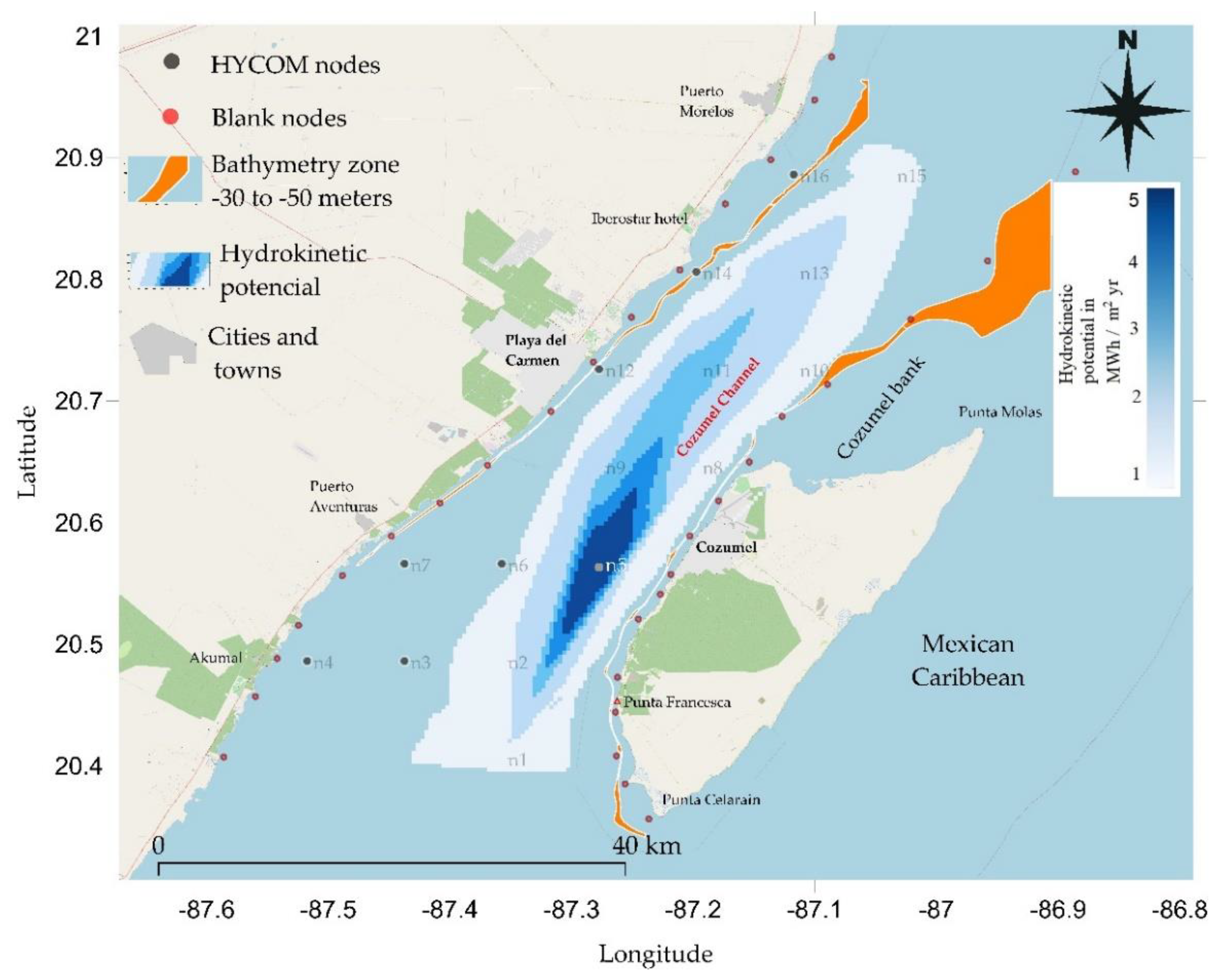
2.4. Estimating Energy Costs
2.5. Methods for Evaluating Environmental and Social Restrictions
3. Results of the Technical Analysis
3.1. Estimating Power Availability
3.2. Reference Data Results
3.3. Technical Availability and Potential Sites
3.4. Capacity Factor
4. Results of the Economic Analysis
4.1. Investment Costs for Each Device
4.2. Levelised Cost of Energy
5. Challenges
5.1. Technical Challenges for the Optimal Turbine
5.2. Social and Environmental Impacts
- The Marine and Regional Ecological Planning Program for the Gulf of Mexico and the Caribbean Sea [71] provides guidance on the use of natural resources and the development of productive activities. It identifies, guides, and links the policies, programs, projects, and actions of the public administration that contribute to achieving the regional goals set, and to optimizing the use of public resources (Figure 10b).
- The Ecological Zoning Programs of the State of Quintana Roo are made up of nine Local Ecological Zoning Programs for which the Ministry of Ecology and Environment is responsible. [78].
6. Conclusions
Author Contributions
Funding
Data Availability Statement
Acknowledgments
Conflicts of Interest
Appendix A
| Node Location | Velocity Range (m/s) | Σ | ||||||||||||||||||||||
|---|---|---|---|---|---|---|---|---|---|---|---|---|---|---|---|---|---|---|---|---|---|---|---|---|
| Node | lat | lon | Std Depth | 0.1 | 0.2 | 0.3 | 0.4 | 0.5 | 0.6 | 0.7 | 0.8 | 0.9 | 1 | 1.1 | 1.2 | 1.3 | 1.4 | 1.5 | 1.6 | 1.7 | 1.8 | 1.9 | <2 | |
| Degres | Degres | m | Hours in Each Velocity Range | h/year | ||||||||||||||||||||
| 1 | 20.32 | −87.12 | 0 | 1 | 17 | 124 | 259 | 527 | 982 | 1556 | 2022 | 1868 | 1019 | 327 | 53 | 6 | 1 | 1 | 0 | 0 | 0 | 0 | 0 | 8760 |
| 1 | 20.32 | −87.12 | 2 | 1 | 7 | 96 | 241 | 490 | 1010 | 1594 | 2156 | 1915 | 937 | 269 | 38 | 4 | 1 | 0 | 0 | 0 | 0 | 0 | 0 | 8760 |
| 1 | 20.32 | −87.12 | 4 | 1 | 2 | 94 | 238 | 481 | 1029 | 1610 | 2223 | 1927 | 890 | 231 | 31 | 3 | 0 | 0 | 0 | 0 | 0 | 0 | 0 | 8760 |
| 1 | 20.32 | −87.12 | 6 | 1 | 1 | 93 | 234 | 471 | 1055 | 1668 | 2299 | 1898 | 819 | 197 | 23 | 2 | 0 | 0 | 0 | 0 | 0 | 0 | 0 | 8760 |
| 1 | 20.32 | −87.12 | 8 | 0 | 2 | 93 | 230 | 476 | 1090 | 1748 | 2393 | 1811 | 737 | 156 | 20 | 2 | 0 | 0 | 0 | 0 | 0 | 0 | 0 | 8760 |
| 1 | 20.32 | −87.12 | 10 | 0 | 2 | 94 | 227 | 480 | 1132 | 1812 | 2443 | 1767 | 663 | 122 | 16 | 1 | 0 | 0 | 0 | 0 | 0 | 0 | 0 | 8760 |
| 1 | 20.32 | −87.12 | 12 | 0 | 4 | 95 | 229 | 490 | 1177 | 1893 | 2465 | 1703 | 597 | 95 | 11 | 1 | 0 | 0 | 0 | 0 | 0 | 0 | 0 | 8760 |
| 1 | 20.32 | −87.12 | 15 | 0 | 4 | 94 | 228 | 521 | 1258 | 1989 | 2516 | 1610 | 468 | 66 | 4 | 1 | 0 | 0 | 0 | 0 | 0 | 0 | 0 | 8760 |
| 1 | 20.32 | −87.12 | 20 | 1 | 7 | 99 | 236 | 610 | 1422 | 2114 | 2557 | 1377 | 297 | 38 | 3 | 0 | 0 | 0 | 0 | 0 | 0 | 0 | 0 | 8760 |
| 1 | 20.32 | −87.12 | 25 | 1 | 13 | 109 | 263 | 734 | 1569 | 2330 | 2443 | 1081 | 198 | 16 | 2 | 0 | 0 | 0 | 0 | 0 | 0 | 0 | 0 | 8760 |
| 1 | 20.32 | −87.12 | 30 | 1 | 22 | 127 | 319 | 881 | 1723 | 2504 | 2242 | 804 | 126 | 11 | 1 | 0 | 0 | 0 | 0 | 0 | 0 | 0 | 0 | 8760 |
| 1 | 20.32 | −87.12 | 35 | 1 | 38 | 127 | 376 | 1046 | 1851 | 2630 | 1994 | 601 | 87 | 7 | 1 | 0 | 0 | 0 | 0 | 0 | 0 | 0 | 0 | 8760 |
| 1 | 20.32 | −87.12 | 40 | 1 | 65 | 121 | 433 | 1188 | 1997 | 2729 | 1730 | 460 | 34 | 3 | 1 | 0 | 0 | 0 | 0 | 0 | 0 | 0 | 0 | 8760 |
| 1 | 20.32 | −87.12 | 45 | 1 | 66 | 118 | 490 | 1305 | 2179 | 2791 | 1489 | 303 | 17 | 1 | 0 | 0 | 0 | 0 | 0 | 0 | 0 | 0 | 0 | 8760 |
| 1 | 20.32 | −87.12 | 50 | 1 | 59 | 124 | 542 | 1462 | 2455 | 2776 | 1171 | 162 | 8 | 1 | 0 | 0 | 0 | 0 | 0 | 0 | 0 | 0 | 0 | 8760 |
| Velocity of Ocean Current (m/s) | |||||||||||||||||||||
|---|---|---|---|---|---|---|---|---|---|---|---|---|---|---|---|---|---|---|---|---|---|
| Turbines | 0.1 | 0.2 | 0.3 | 0.4 | 0.5 | 0.6 | 0.7 | 0.8 | 0.9 | 1 | 1.1 | 1.2 | 1.3 | 1.4 | 1.5 | 1.6 | 1.7 | 1.80 | 1.90 | 2.00 | 2.10 |
| η(U) | |||||||||||||||||||||
| SeaGen 1 | 0.00 | 0.00 | 0.00 | 0.00 | 0.20 | 0.27 | 0.35 | 0.43 | 0.40 | 0.40 | 0.40 | 0.40 | 0.42 | 0.45 | 0.41 | 0.42 | 0.44 | 0.40 | 0.42 | 0.43 | 0.36 |
| Nova 2 | 0.00 | 0.00 | 0.00 | 0.00 | 0.00 | 0.07 | 0.15 | 0.23 | 0.33 | 0.42 | 0.44 | 0.47 | 0.46 | 0.46 | 0.43 | 0.39 | 0.36 | 0.28 | 0.22 | 0.17 | 0.14 |
| Kairyu 3 | 0.00 | 0.00 | 0.00 | 0.00 | 0.00 | 0.00 | 0.00 | 0.00 | 0.43 | 0.55 | 0.55 | 0.55 | 0.49 | 0.43 | 0.31 | 0.27 | 0.24 | 0.18 | 0.14 | 0.11 | 0.09 |
| TidGen 4 | 0.00 | 0.00 | 0.00 | 0.00 | 0.00 | 0.00 | 0.00 | 0.00 | 0.15 | 0.19 | 0.20 | 0.21 | 0.21 | 0.22 | 0.16 | 0.14 | 0.12 | 0.09 | 0.07 | 0.06 | 0.05 |
References
- Gross, R.; Leach, M.; Bauen, A. Progress in Renewable Energy. Environ. Int. 2003, 29, 105–122. [Google Scholar] [CrossRef]
- Hussain, A.; Arif, S.M.; Aslam, M. Emerging Renewable and Sustainable Energy Technologies: State of the Art. Renew. Sustain. Energy Rev. 2017, 71, 12–28. [Google Scholar] [CrossRef]
- Halkos, G.E.; Gkampoura, E.-C. Reviewing Usage, Potentials, and Limitations of Renewable Energy Sources. Energies 2020, 13, 2906. [Google Scholar] [CrossRef]
- Roy, A.; Auger, F.; Dupriez-Robin, F.; Bourguet, S.; Tran, Q.T. Electrical Power Supply of Remote Maritime Areas: A Review of Hybrid Systems Based on Marine Renewable Energies. Energies 2018, 11, 1904. [Google Scholar] [CrossRef]
- Tomabechi, K. Energy Resources in the Future. Energies 2010, 3, 686–695. [Google Scholar] [CrossRef]
- Hernández-Fontes, J.V.; Felix, A.; Mendoza, E.; Cueto, Y.R.; Silva, R. On the Marine Energy Resources of Mexico. J. Mar. Sci. Eng. 2019, 7, 191. [Google Scholar] [CrossRef]
- Quitoras, M.R.D.; Abundo, M.L.S.; Danao, L.A.M. A Techno-Economic Assessment of Wave Energy Resources in the Philippines. Renew. Sustain. Energy Rev. 2018, 88, 68–81. [Google Scholar] [CrossRef]
- Chassignet, E.P.; Hurlburt, H.E.; Metzger, E.J.; Smedstad, O.M.; Cummings, J.A.; Halliwell, G.R.; Bleck, R.; Baraille, R.; Wallcraft, A.J.; Lozano, C.; et al. Global Ocean Prediction with the Hybrid Coordinate Ocean Model (HYCOM). Oceanography 2009, 22, 13. [Google Scholar] [CrossRef]
- Bane, J.M.; He, R.; Muglia, M.; Lowcher, C.F.; Gong, Y.; Haines, S.M. Marine Hydrokinetic Energy from Western Boundary Currents. Annu. Rev. Mar. Sci. 2017, 9, 105–123. [Google Scholar] [CrossRef]
- Gründlingh, M.L. On the Course of the Agulhas Current. S. Afr. Geogr. J. 1983, 65, 49–57. [Google Scholar] [CrossRef]
- Lutjeharms, J.R. The Agulhas Current; Springer: Berlin, Germany, 2006; Volume 329. [Google Scholar]
- Barkley, R. The Kuroshio Current. Sci. J. 1970, 6, 54–60. [Google Scholar]
- Sawada, K.; Handa, N. Variability of the Path of the Kuroshio Ocean Current over the Past 25,000 Years. Nature 1998, 392, 592–595. [Google Scholar] [CrossRef]
- Fofonoff, N. The Gulf Stream. In Evolution of Physical Oceanography: Scientific Surveys in Honor of Henry Stommel; Warren, B.A., Wunsch, C., Eds.; MIT Press: Cambridge, MA, USA, 1981; pp. 112–139. [Google Scholar]
- Stommel, H.M. The Gulf Stream: A Physical and Dynamical Description; University of California Press: Berkeley, CA, USA, 1965. [Google Scholar]
- Davis, B.; Farrel, J.; Swan, D.; Jeffers, K. Generation of Electrical Power from the Florida Current of the Gulf Stream. In Proceedings of the Offshore Technology Conference, Houston, TX, USA, 5–8 May 1986. [Google Scholar]
- Alcérreca-Huerta, J.C.; Encarnacion, J.I.; Ordoñez-Sánchez, S.; Callejas-Jiménez, M.; Gallegos Diez Barroso, G.; Allmark, M.; Mariño-Tapia, I.; Silva Casarín, R.; O’Doherty, T.; Johnstone, C.; et al. Energy Yield Assessment from Ocean Currents in the Insular Shelf of Cozumel Island. JMSE 2019, 7, 147. [Google Scholar] [CrossRef]
- Marais, E.; Chowdhury, S.; Chowdhury, S. Theoretical Resource Assessment of Marine Current Energy in the Agulhas Current along South Africa’s East Coast. In Proceedings of the 2011 IEEE Power and Energy Society General Meeting, Detroit, MI, USA, 24–28 July 2011; pp. 1–8. [Google Scholar]
- Meyer, I.; Van Niekerk, J.L. Towards a Practical Resource Assessment of the Extractable Energy in the Agulhas Ocean Current. Int. J. Mar. Energy 2016, 16, 116–132. [Google Scholar] [CrossRef]
- Wright, S.; Chowdhury, S.; Chowdhury, S. A Feasibility Study for Marine Energy Extraction from the Agulhas Current. In Proceedings of the 2011 IEEE Power and Energy Society General Meeting, Detroit, MI, USA, 24–28 July 2011; pp. 1–9. [Google Scholar]
- Moodley, R.; Nthontho, M.; Chowdhury, S.; Chowdhury, S. A Technical and Economic Analysis of Energy Extraction from the Agulhas Current on the East Coast of South Africa. In Proceedings of the 2012 IEEE Power and Energy Society General Meeting, San Diego, CA, USA, 22–26 July 2012; pp. 1–8. [Google Scholar]
- Chang, M.-H.; Tang, T.Y.; Ho, C.-R.; Chao, S.-Y. Kuroshio-Induced Wake in the Lee of Green Island off Taiwan. J. Geophys. Res. Ocean. 2013, 118, 1508–1519. [Google Scholar] [CrossRef]
- Hsu, T.-W.; Liau, J.-M.; Liang, S.-J.; Tzang, S.-Y.; Doong, D.-J. Assessment of Kuroshio Current Power Test Site of Green Island, Taiwan. Renew. Energy 2015, 81, 853–863. [Google Scholar] [CrossRef]
- Kiyomatsu, K.; Kodaira, T.; Kadomoto, Y.; Waseda, T.; Takagi, K. Adcp Measurements of Ocean Currents near Miyake Island. J. Jpn. Soc. Nav. Archit. Ocean Eng. 2014, 20. [Google Scholar] [CrossRef]
- Kodaira, T.; Waseda, T.; Nakagawa, T.; Isoguchi, O.; Miyazawa, Y. Measuring the Kuroshio Current around Miyake Island, a Potential Site for Ocean-Current Power Generation. Int. J. Offshore Polar Eng. 2013, 23, 272–278. [Google Scholar]
- Liu, T.; Wang, B.; Hirose, N.; Yamashiro, T.; Yamada, H. High-Resolution Modeling of the Kuroshio Current Power South of Japan. J. Ocean Eng. Mar. Energy 2018, 4, 37–55. [Google Scholar] [CrossRef]
- Webb, A.; Waseda, T.; Kiyomatsu, K. A High-Resolution, Long-Term Wave Resource Assessment of Japan with Wave–Current Effects. Renew. Energy 2020, 161, 1341–1358. [Google Scholar] [CrossRef]
- Chen, F. Kuroshio Power Plant Development Plan. Renew. Sustain. Energy Rev. 2010, 14, 2655–2668. [Google Scholar] [CrossRef]
- VanSwieten, J.H.; Meyer, I.; Alsenas, G.M. Evaluation of Hycom as a Tool for Ocean Current Energy Assessment. In Proceedings of the 2nd Marine Energy Technology Symposium METS14, Seattle, WA, USA, 15–18 April 2014; p. 11. [Google Scholar]
- Yang, X.; Haas, K.A.; Fritz, H.M. Evaluating the Potential for Energy Extraction from Turbines in the Gulf Stream System. Renew. Energy 2014, 72, 12–21. [Google Scholar] [CrossRef]
- Yang, X.; Haas, K.A.; Fritz, H.M. Theoretical Assessment of Ocean Current Energy Potential for the Gulf Stream System. Mar. Technol. Soc. J. 2013, 47, 101–112. [Google Scholar] [CrossRef]
- Duerr, A.; Dhanak, M. Hydrokinetic Power Resource Assessment of the Florida Current. In Proceedings of the OCEANS 2010 MTS/IEEE SEATTLE, Seattle, WA, USA, 20–23 September 2010; pp. 1–7. [Google Scholar]
- Duerr, A.E.; Dhanak, M.R. An Assessment of the Hydrokinetic Energy Resource of the Florida Current. IEEE J. Ocean. Eng. 2012, 37, 281–293. [Google Scholar] [CrossRef]
- Kang, D.; Curchitser, E.N.; Rosati, A. Seasonal Variability of the Gulf Stream Kinetic Energy. J. Phys. Oceanogr. 2016, 46, 1189–1207. [Google Scholar] [CrossRef]
- Kabir, A.; Lemongo-Tchamba, I.; Fernandez, A. An Assessment of Available Ocean Current Hydrokinetic Energy near the North Carolina Shore. Renew. Energy 2015, 80, 301–307. [Google Scholar] [CrossRef]
- Encarnacion, J.I.; Johnstone, C.; Ordonez-Sanchez, S. Design of a Horizontal Axis Tidal Turbine for Less Energetic Current Velocity Profiles. J. Mar. Sci. Eng. 2019, 7, 197. [Google Scholar] [CrossRef]
- Byun, D.S.; Hart, D.E.; Jeong, W.J. Tidal Current Energy Resources off the South and West Coasts of Korea: Preliminary Observation-Derived Estimates. Energies 2013, 6, 566–578. [Google Scholar] [CrossRef]
- Nim IV, C. The Political Ecology of Environmental Change and Tourist Development in Cozumel, Mexico. Ph.D. Thesis, Miami University, Oxford, OH, USA, 2006. [Google Scholar]
- Hernández-Fontes, J.V.; Martínez, M.L.; Wojtarowski, A.; González-Mendoza, J.L.; Landgrave, R.; Silva, R. Is Ocean Energy an Alternative in Developing Regions? A Case Study in Michoacan, Mexico. J. Clean. Prod. 2020, 266, 121984. [Google Scholar] [CrossRef]
- Cetina, P.; Candela, J.; Sheinbaum, J.; Ochoa, J.; Badan, A. Circulation along the Mexican Caribbean Coast. J. Geophys. Res. Ocean. 2006, 111. [Google Scholar] [CrossRef]
- Secretaría de Energía Dirección General de Planeación e Información Energéticas Sistema de Información Energética. Available online: http://sie.energia.gob.mx/ (accessed on 29 March 2021).
- Centro Nacional de Control de Energía. Programa de Desarrollo del Sistema Electrico Nacional 2018–2032; Secretaría de Energía: Mexico City, México, 2018; p. 330. [Google Scholar]
- Muckelbauer, G. The Shelf of Cozumel, Mexico: Topography and Organisms. Facies 1990, 23, 201–239. [Google Scholar] [CrossRef]
- Instituto Nacional de Estadística y Geografía International Bathymetric Chart of the Caribbean Sea and the Gulf of Mexico, Chart 1-06. 2018. Available online: https://www.ngdc.noaa.gov/mgg/ibcca/ib_start.htm (accessed on 29 March 2021).
- Chávez, G.; Candela, J.; Ochoa, J. Subinertial Flows and Transports in Cozumel Channel. J. Geophys. Res. Ocean. 2003, 108. [Google Scholar] [CrossRef]
- Secretaría de Marina. S.M. 922.1 Costa Este, Isla Mujeres a Isla Cozumel; Secretaría de Marina: Mexico City, Mexico, 2003. [Google Scholar]
- Nova-Innovation Tidal Turbines: Nova M100-D. Available online: https://www.novainnovation.com/tidalturbines (accessed on 11 July 2020).
- Power-Technology SeaGen Turbine, Northern Ireland. Available online: https://www.power-technology.com/projects/strangford-lough/ (accessed on 2 August 2020).
- Nikkei Electricity from Ocean Currents: Japanese Company to Begin Experiment (Photo Credits by Annu Nishioka). Available online: https://asia.nikkei.com/Spotlight/Environment/Electricity-from-ocean-currents-Japanese-company-to-begin-experiment (accessed on 25 May 2020).
- ECO. ORPC Ireland Selected for Major Ocean Energy Project (Photo Credits by ORCP). Available online: https://www.ecomagazine.com/news/industry/orpc-ireland-selected-for-major-ocean-energy-project (accessed on 13 April 2020).
- Innovation, N. Products—Nova Innovation. Available online: https://www.novainnovation.com/products/ (accessed on 29 March 2021).
- Scottish-Energy-News Major Boost for Scottish Tidal Energy Industry as Atlantis Takes over of Siemens’ UK Marine-Power Subsidiary (Photo Credits by Siemens AG). Available online: http://www.scottishenergynews.com/major-boost-for-scottish-wave-energy-industry-as-atlantis-takes-over-of-siemens-uk-marine-power-subsidiary/ (accessed on 11 July 2020).
- Boehme, T.; Taylor, J.; Wallace, R.; Bialek, J. Matching Renewable Electricity Generation With Demand; Academic Study; The University of Edinburgh: Edinburgh, Scotland, 2006; p. 77. [Google Scholar]
- IHI Corporation Power Generation Using the Kuroshio Current. IHI Eng. Rev. 2014, 46, 4.
- Ocean Renewable Power Company TidGen Power System. Available online: https://www.orpc.co/our-solutions/scalable-grid-integrated-systems/tidgen-power-system (accessed on 29 March 2021).
- VanZwieten, J.; McAnally, W.; Ahmad, J.; Davis, T.; Martin, J.; Bevelhimer, M.; Cribbs, A.; Lippert, R.; Hudon, T.; Trudeau, M. In-Stream Hydrokinetic Power: Review and Appraisal. J. Energy Eng. 2014, 141, 16. [Google Scholar] [CrossRef]
- OPeNDAPTM. Advanced Software for Remote Data Retrieval. Available online: https://www.opendap.org/ (accessed on 30 March 2021).
- HYCOM Consortium HYCOM Data Server. Available online: https://www.hycom.org/dataserver (accessed on 30 March 2021).
- Pierce, D. Ncdf4: Interface to Unidata NetCDF; RCoreTeam: Vienna, Austria, 2019. [Google Scholar]
- Vazquez, A.; Iglesias, G. Capital Costs in Tidal Stream Energy Projects–A Spatial Approach. Energy 2016, 107, 215–226. [Google Scholar] [CrossRef]
- IOC; SCOR; IAPSO. The International Thermodynamic Equation of Seawater—2010. Calculation and Use of Thermodynamic Properties. Intergovernmental Oceanographic Commission, Manuals and Guides No. 56, UNESCO (English). 2010, p. 196. Available online: http://www.teos-10.org/pubs/TEOS-10_Manual.pdf (accessed on 30 March 2021).
- QGIS Project 23.1.5. Interpolación—Documentación de QGIS Documentation. Available online: https://docs.qgis.org/3.10/es/docs/user_manual/processing_algs/qgis/interpolation.html?highlight=tin#tin-interpolation (accessed on 30 March 2021).
- Secretaría-de-Marina. Catálogo de Cartas y Publicaciones Náuticas; Secretaría-de-Marina: Mexico City, Mexico, 2021; p. 25, Nautical Chart S.M. 922., S. M. 922.1, S. M. 922.2, S. M. 922.3, S. M. 922.4, S. M. 922.5, S. M. 922.6 y S. M. 922.7. 2021. [Google Scholar]
- Comisión Nacional de Áreas Naturales Protegidas Información espacial de las Áreas Naturales Protegidas CONANP. Available online: http://sig.conanp.gob.mx/website/pagsig/info_kml.htm (accessed on 30 March 2021).
- Secretaría de Marina. S.M. 922-4, Isla de Cozumel Q Roo; Secretaría de Marina: Mexico City, Mexico, 2010. [Google Scholar]
- Secretaría de Comunicaciones y Transporte Informe Estadístico Mensual. Movimiento de Carga, Buques y Pasajeros En Los Puerto de México. Available online: https://www.gob.mx/sct (accessed on 31 March 2021).
- Secretaría de Energía. Centro Nacional de Control de Energía Programa de Ampliación y Modernización de la Red Nacional de Trasmisión y Redes Generales de Distribución del Mercado Eléctrico Mayorista, PRODESEN 2019–2033; Secretaría de Energía: Mexico City, México, 2019; p. 576. [Google Scholar]
- Ocean Energy Systems International Levelised Cost Of Energy for Ocean Energy Technologies, An Analysis of the Development Pathway and Levelised Cost of Energy Trajectories of Wave, Tidal and OTEC Technologies. Available online: https://www.ocean-energy-systems.org/documents/65931-cost-of-energy-for-ocean-energy-technologies-may-2015-final.pdf/ (accessed on 31 March 2021).
- Wave Energy Centre; Co-ordinated Action of Ocean Energy EU funded Project (CA-OE); Implementing Agreement on Ocean Energy Systems (IEA-OES). Ocean Energy Glossary; Ocean Energy Systems: Lisbon, Portugal, 2007; p. 14. [Google Scholar]
- IFT. Instituto de Federal de Telecomunicaciones IFT Portal de Internet. Available online: www.ift.org.mx (accessed on 7 November 2020).
- Secretarias de Gobernación, Diario Oficial de la Federación ACUERDO Por El Que Se Expide La Parte Marina Del Programa de Ordenamiento Ecológico Marino y Regional Del Golfo de México y Mar Caribe y Se Da a Conocer La Parte Regional Del Propio Programa (Continúa En La Segunda Sección). Available online: http://dof.gob.mx/nota_detalle_popup.php?codigo=5279084 (accessed on 18 March 2021).
- Comisión Nacional de Áreas Naturales Protegidas Portal de Información Geográfica—CONABIO. Available online: http://www.conabio.gob.mx/informacion/gis/?vns=gis_root/biodiv/monmang/bimagstipr/sitpriogw (accessed on 12 March 2021).
- Google Google Earth Pro. Available online: https://www.google.com/intl/es/earth/download/gep/agree.html (accessed on 30 March 2021).
- Golden Software. Inc Full User’s Guide Golden Software, Inc.; Golden Software: Golden, CO, USA, 2012. [Google Scholar]
- Copping, A.; Hanna, L.; Whiting, J.; Geerlofs, S.; Grear, M.; Blake, K.; Coffey, A.; Massaua, M.; Brown-Saracino, J.; Battey, H. Environmental Effects of Marine Energy Development around the World Annex IV Final Report; Ocean Energy Systems: Lisbon, Portugal, 2013; p. 96. [Google Scholar]
- Martínez, M.L.; Vázquez, G.; Pérez-Maqueo, O.; Silva, R.; Moreno-Casasola, P.; Mendoza-González, G.; López-Portillo, J.; MacGregor-Fors, I.; Heckel, G.; Hernández-Santana, J.R.; et al. A Systematic View of Potential Environmental Impacts of Ocean Energy Production. Renew. Sustain. Energy Rev. 2021, 149, 111332. [Google Scholar] [CrossRef]
- Wiltschko, W.; Wiltschko, R. Magnetic Orientation and Magnetoreception in Birds and Other Animals. J. Comp. Physiol. A 2005, 191, 675–693. [Google Scholar] [CrossRef]
- Secretaría de Ecología y Medio Ambiente Ordenamiento Ecológico, Secretaría de Ecología y Medio Ambiente, Del Estado de Quintana Roo. Available online: http://sema.qroo.gob.mx/bitacora/index.php/ordenamiento-ecologico (accessed on 24 May 2021).
- Secretaría de Medio Ambiente y Recursos Naturales. NORMA Oficial Mexicana NOM-059-SEMARNAT-2010, Protección Ambiental-Especies Nativas de México de Flora Y Fauna Silvestres-Categorías de Riesgo Y Especificaciones Para Su Inclusión, Exclusión o cambio-Lista de Especies En Riesgo; Secretaría de Medio Ambiente y Recursos Naturales: Mexico City, Mexico, 2010; Volume NOM-059-SEMARNAT-2010, p. 78. [Google Scholar]
- Naviera M29 Transcaribe, Naviera M29. Available online: https://transcaribe.net/ (accessed on 30 March 2021).
- Ultramar Ultramar, Rutas y Horarios, Ferry Pasajeros. Available online: https://www.ultramarferry.com/es/rutas-y-horarios (accessed on 30 March 2021).
- Ultramar Carga Ultramar Carga—Experience Innovation. Available online: http://ultramarcarga.com/ (accessed on 30 March 2021).
- Instituto Nacional de Pesca Acciones y Programas. Available online: https://www.gob.mx/inapesca (accessed on 31 March 2021).
- Subsecretaría de Planeación y Política Ambiental; Dirección General de Políticas para el Cambio Climático. AVISO. Para El Reporte del Registro Nacional de Emisiones; SEMARNAT: México City, Mexico, 2015; p. 1. [Google Scholar]
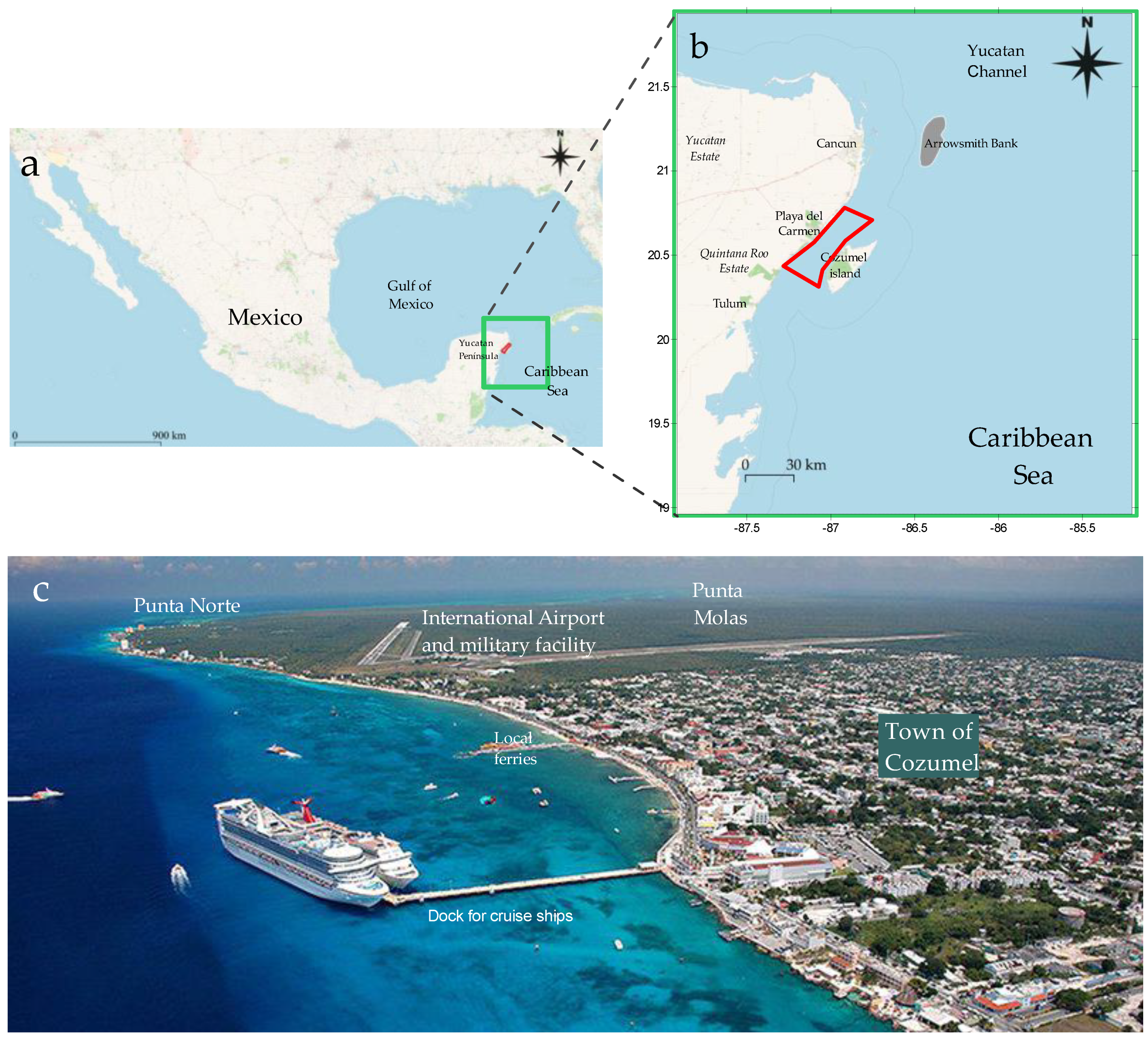

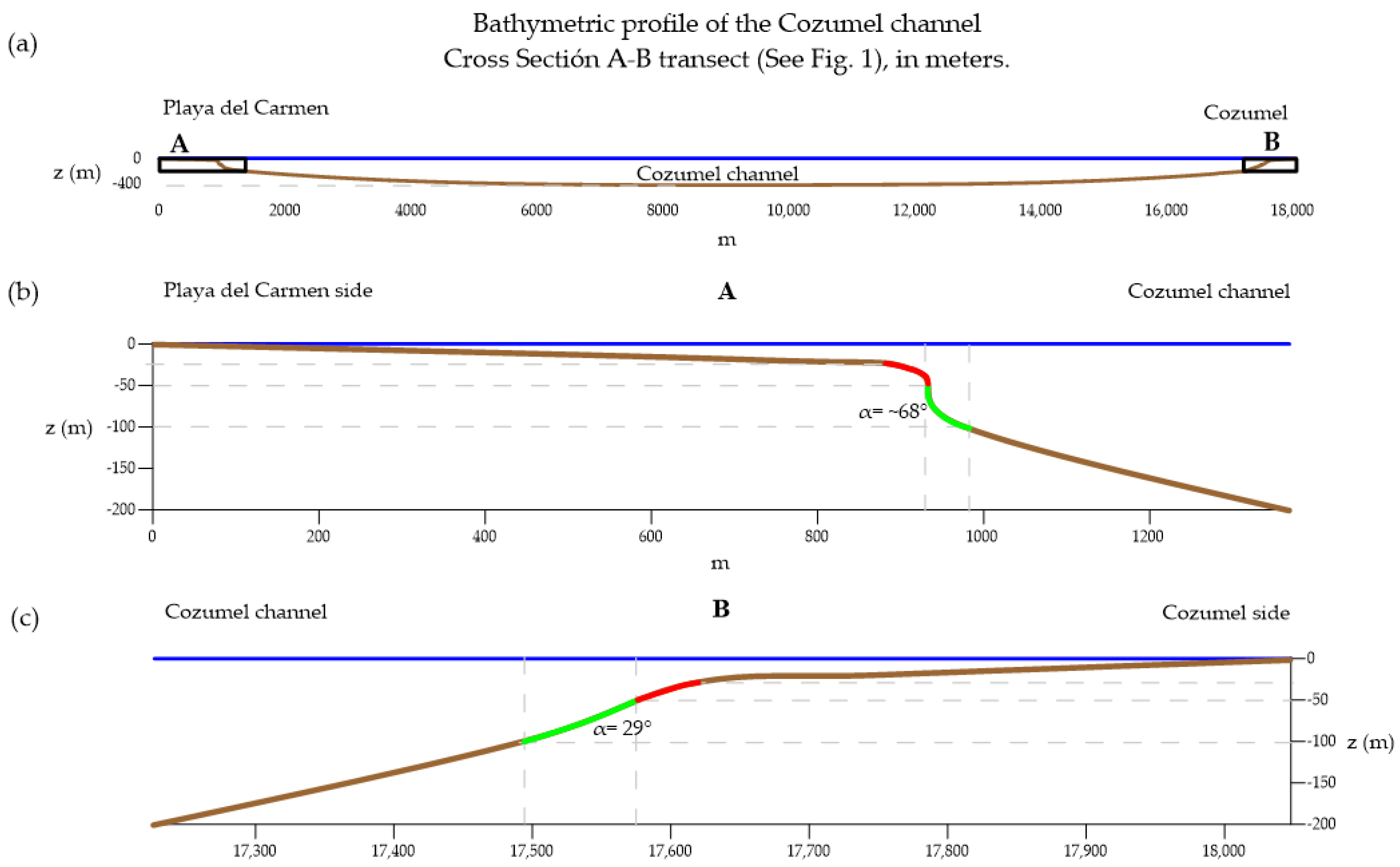
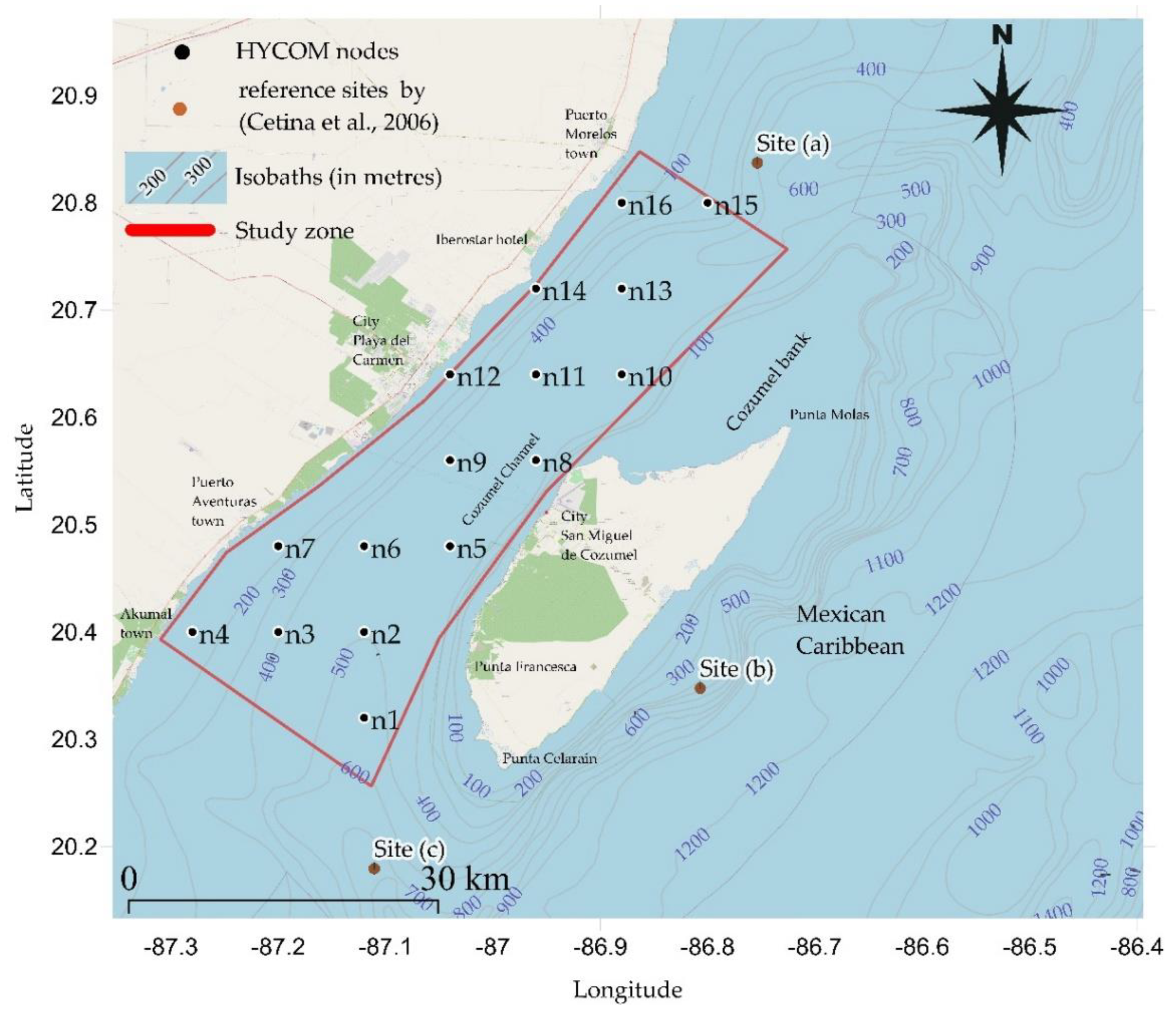
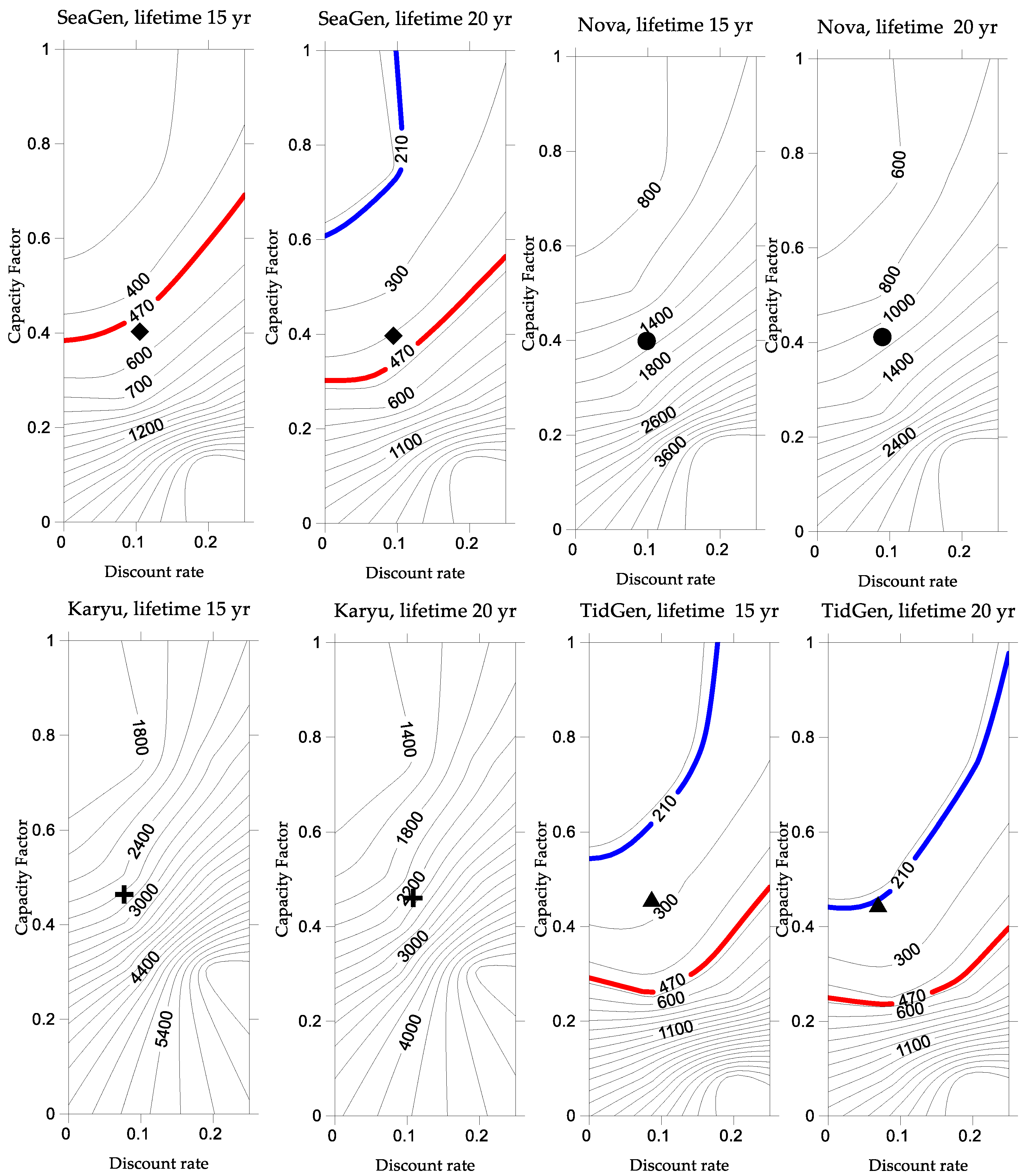

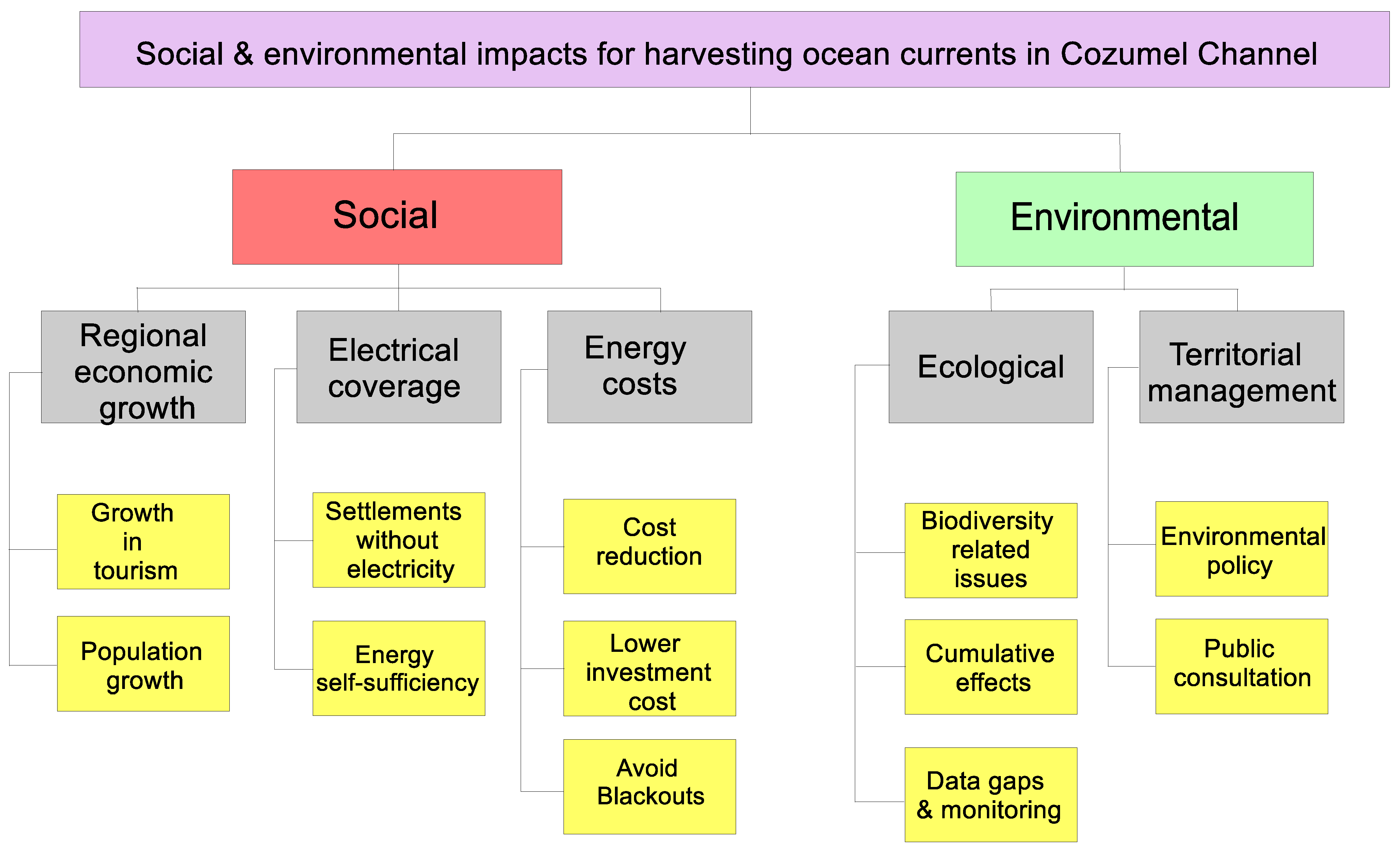

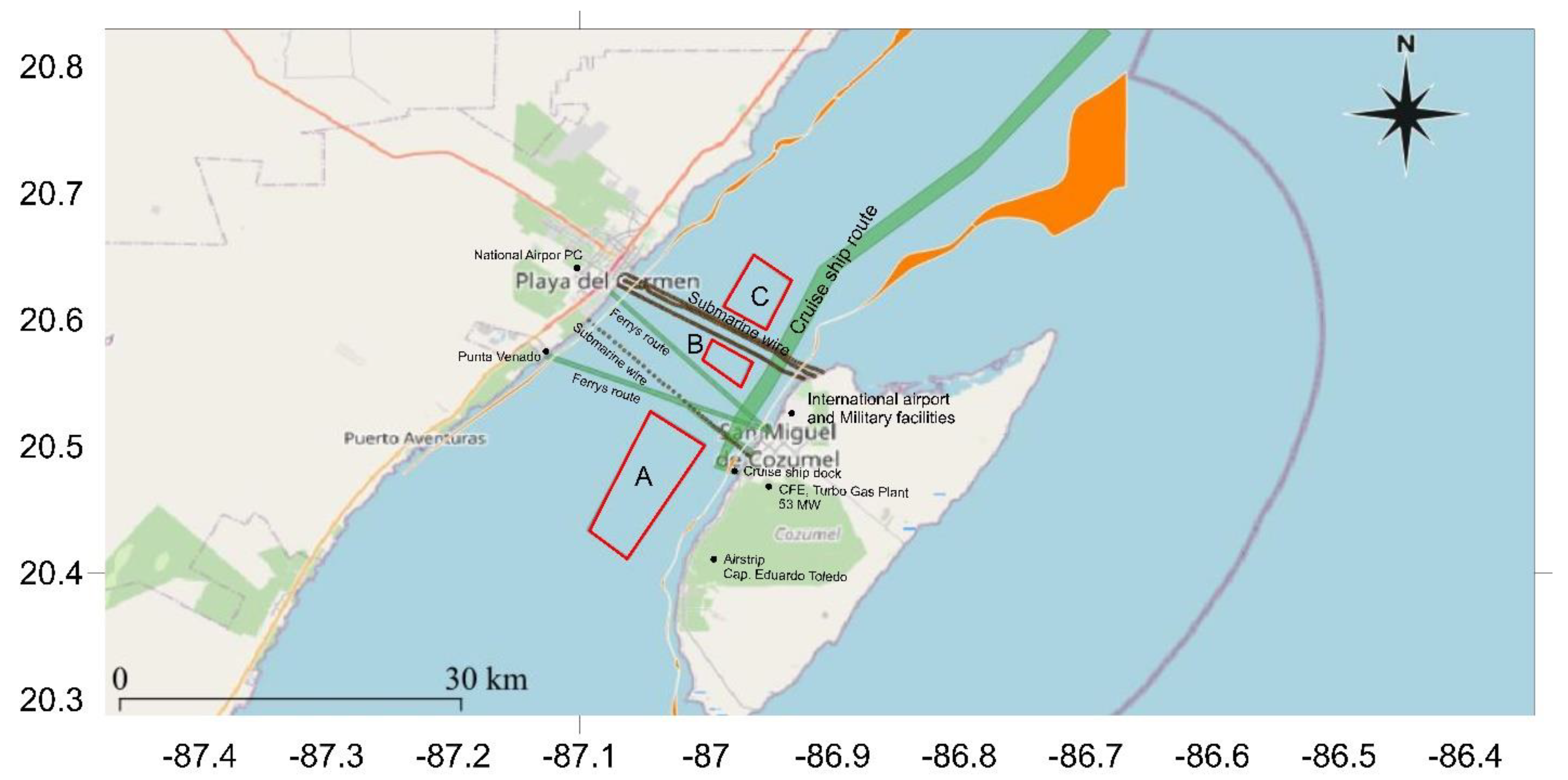
| Location | Long | Lat | Distance to the Coast | Mean Hidrokinetic Energy Potential | Mean Direction | Standard Deviation | Source |
|---|---|---|---|---|---|---|---|
| Degrees | Degrees | km | MWh/m2-year | Degrees | Degrees | ||
| Puerto Morelos | −86.751 | 20.841 | 12 | 9.85 | 45 | 1.3 | Data from [40] |
| Cozumel east coast | −86.751 | 20.841 | 8 | 3.27 | 51 | 0.4 | |
| Tulum | −87.138 | 20.079 | 17 | 1.54 | 79 | 0.4 |
| Turbine | 1 | 2 | 3 | 4 | 5 | 6 | 7 | 8 | 9 | 10 | 11 | 12 | 13 | 14 | 15 | 16 |
|---|---|---|---|---|---|---|---|---|---|---|---|---|---|---|---|---|
| Sea Gen | 381 | 392 | 37 | 0 | 1319 | 121 | 0 | 380 | 600 | 334 | 660 | 29 | 563 | 38 | 234 | 6 |
| Nova | 28 | 29 | 1 | 0 | 151 | 5 | 0 | 30 | 58 | 24 | 66 | 0 | 54 | 1 | 16 | 0 |
| Kairyu | 37 | 41 | 0 | 0 | 269 | 0 | 0 | 45 | 108 | 32 | 123 | 0 | 99 | 0 | 21 | 0 |
| TidGen | 9 | 8 | 0 | 0 | 65 | 0 | 0 | 9 | 23 | 6 | 26 | 0 | 21 | 0 | 4 | 0 |
| Capacity Factor (in %) of Each Device and at Each Node | ||||||||||||||||
|---|---|---|---|---|---|---|---|---|---|---|---|---|---|---|---|---|
| Device | 1 | 2 | 3 | 4 | 5 | 6 | 7 | 8 | 9 | 10 | 11 | 12 | 13 | 14 | 15 | 16 |
| Sea Gen | 3.6 | 3.7 | 0.4 | 0.0 | 12.5 | 1.1 | 0.0 | 3.6 | 5.7 | 3.2 | 6.3 | 0.28 | 5.36 | 0.36 | 2.228 | 0.05 |
| Nova | 3.2 | 3.4 | 0.1 | 0.0 | 17.3 | 0.5 | 0.0 | 3.4 | 6.7 | 2.7 | 7.6 | 0.04 | 6.19 | 0.08 | 1.829 | 0.00 |
| Kairyu | 4.2 | 4.7 | 0.0 | 0.0 | 30.7 | 0.0 | 0.0 | 5.1 | 12.3 | 3.7 | 14.0 | 0.00 | 11.25 | 0.00 | 2.421 | 0.00 |
| TidGen | 1.0 | 0.9 | 0.0 | 0.0 | 7.4 | 0.0 | 0.0 | 1.0 | 2.6 | 0.7 | 3.0 | 0.00 | 2.35 | 0.00 | 0.490 | 0.00 |
| Device | 1 Public CAPEX | Ranc CAPEX 2 | Calculated CAPEX 3 | |
|---|---|---|---|---|
| USD/kW | Min USD/kW | Max USD/kW | USD/kW | |
| Sea Gen | 12,500 | 5100 | 14,600 | 5985 |
| Nova | 37,400 | 22,959 | ||
| Kairyu | 92,500 | 24,615 | ||
| TidGen | 8000 | 16,501 | ||
| Device | Public LCOE 5 | Ranc LCOE 6 | Calculated LCOE 7 | |
|---|---|---|---|---|
| USD/MWh | Min USD/MWh | Max USD/MWh | USD/MWh | |
| Sea Gen 1 | N/A | 210 | 470 | 1148 |
| Nova 2 | N/A | 2264 | ||
| Kairyu 3 | N/A | 4012 | ||
| TidGen 4 | N/A | 1673 | ||
| Zone | Area (km2) | Areas Vertices | |||
|---|---|---|---|---|---|
| A | 60 | −87.0436, 20.5276 | −87.007, 20.5012 | −87.0933, 20.4337 | −87.06181, 20.41159 |
| B | 10 | −86.9952, 20.5837 | −86.9730, 20.5473 | −86.9646, 20.5666 | −87.0032, 20.5685 |
| C | 20 | −86.96285, 20.65161 | −86.95320, 20.59284 | −86.93344, 20.63027 | −86.986938, 20.610492 |
Publisher’s Note: MDPI stays neutral with regard to jurisdictional claims in published maps and institutional affiliations. |
© 2021 by the authors. Licensee MDPI, Basel, Switzerland. This article is an open access article distributed under the terms and conditions of the Creative Commons Attribution (CC BY) license (https://creativecommons.org/licenses/by/4.0/).
Share and Cite
Bárcenas Graniel, J.F.; Fontes, J.V.H.; Garcia, H.F.G.; Silva, R. Assessing Hydrokinetic Energy in the Mexican Caribbean: A Case Study in the Cozumel Channel. Energies 2021, 14, 4411. https://doi.org/10.3390/en14154411
Bárcenas Graniel JF, Fontes JVH, Garcia HFG, Silva R. Assessing Hydrokinetic Energy in the Mexican Caribbean: A Case Study in the Cozumel Channel. Energies. 2021; 14(15):4411. https://doi.org/10.3390/en14154411
Chicago/Turabian StyleBárcenas Graniel, Juan F., Jassiel V. H. Fontes, Hector F. Gomez Garcia, and Rodolfo Silva. 2021. "Assessing Hydrokinetic Energy in the Mexican Caribbean: A Case Study in the Cozumel Channel" Energies 14, no. 15: 4411. https://doi.org/10.3390/en14154411
APA StyleBárcenas Graniel, J. F., Fontes, J. V. H., Garcia, H. F. G., & Silva, R. (2021). Assessing Hydrokinetic Energy in the Mexican Caribbean: A Case Study in the Cozumel Channel. Energies, 14(15), 4411. https://doi.org/10.3390/en14154411









